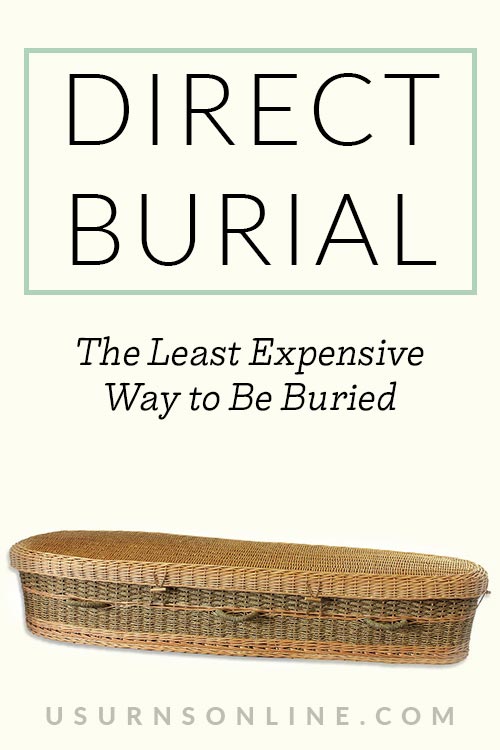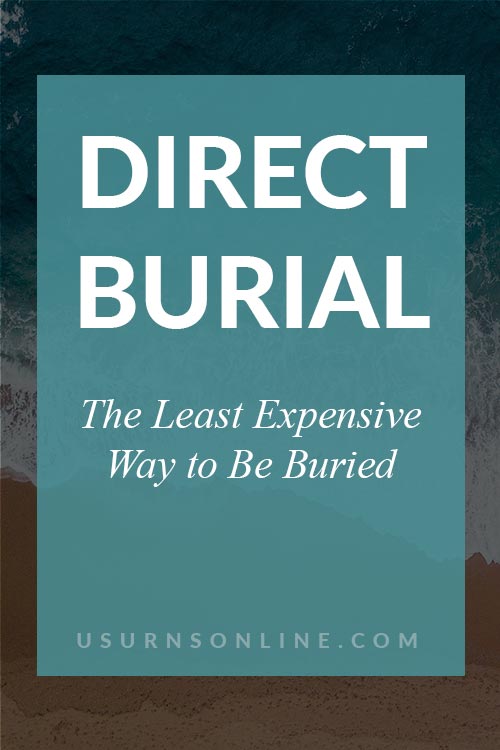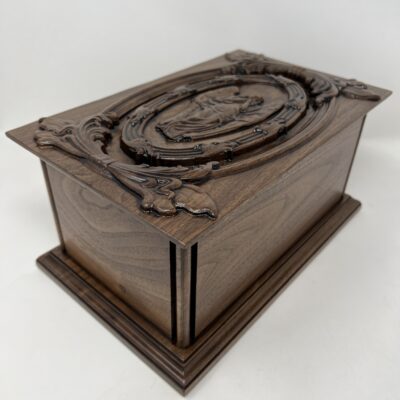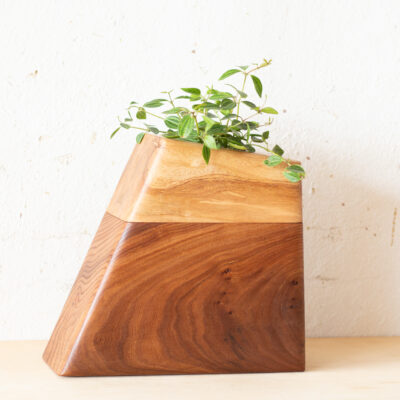Funerals are expensive. Whether you have a funeral to plan right now or are planning ahead, you want to get the best prices.
Hands down, direct burial is the least expensive burial option. And it’s not even close.
But direct burial does have its downsides. Can you still have a traditional funeral, or even graveside committal? How “direct”, exactly, is direct burial? Will your family still have the time and opportunity to mourn your loved one?
Continue reading and we’ll tell you all about direct burial, including what it is, how much it costs, plus all the pros and cons.
What Is the Least Expensive Burial Option?
With 46% of Americans choosing burial over cremation, there needs to be an affordable option for burial. The least expensive option is known as direct burial.
With a direct burial, the body is buried soon after death, with no embalming or visitation. There would be no extra expenses, just the casket, the gravesite, and the cemetery fees.
What Is Direct Burial?
Direct burial is the simplest form of burial a funeral home can offer. The body is picked up, placed in a minimal casket, transported to the cemetery, and buried. The close family often has a brief, no-frills graveside service at the time of burial.
All this happens within a matter of days. The funeral home may store the body for a short period of time while you make any necessary arrangements.
A direct burial is similar to direct cremation in its simplicity. There is no formal funeral service conducted, and many of the products and services associated with the cost of a traditional burial are removed.
There is no viewing, visitation, or funeral ceremony. The timeframe is short, so the deceased does not need to be embalmed – these are all costs that the family will not have to incur. Therefore this saves a lot of money.
Urns Made in the USA
How is Direct Burial Different from Other Options?
Direct burial is different from traditional burial because there is no funeral service, fancy casket, embalming, and so on. It clearly differs from cremation because the body is buried rather than cremated.
Natural burial is, in some ways, similar, but direct burial is not necessarily “eco-friendly” whereas natural burial is very conscious about energy and resource usage.
Here’s a look at the other options, and some things you would not have (and not have to pay for) should you choose direct burial.
Traditional Burial
Traditional burial typically begins with a funeral service. The funeral usually includes items such as readings, eulogies, prayers, and music. Afterward, the body is taken by a procession to the cemetery and interred in the grave.
The family may or may not have a graveside service. After the short graveside service, the casket will be lowered into the grave. Following the burial, the family may host a reception at their home or a restaurant.
Read more about these things in our Guide to Traditional Burial.
Cremation
There are a few ways to hold (or not hold) a cremation service.
Traditional service followed by cremation. There is often a visitation and a typical funeral service. These will happen within a few days after death. The funeral service is followed by cremation rather than a burial. After the cremation process is complete, the cremated remains can be buried, scattered, or returned to the family in a cremation urn.
Memorial service after cremation. The memorial service is just like a funeral service, but without the body present. The cremation takes place with the memorial service following sometime after – the service can wait for weeks or even months after the death. An urn holding the cremated remains will likely be present at the service. The final disposition of the cremated remains would take place after the service. They can be buried, placed in a niche, scattered, or the family may choose to take the cremains home.
Direct cremation. This is the most basic type of cremation. It is sometimes called immediate cremation or simple cremation. With direct cremation, the body is cremated right away, and the cremated remains are returned to the family. There is no funeral, graveside, or memorial service. The family can choose to do this in their own time, and in their own way, without the involvement of the funeral home.
Natural Burial
Natural burial is an alternative to a traditional burial. With natural or “green” burial, the body is not embalmed, and it is not placed into a traditional casket or burial vault.
Everything in the burial process is done naturally – the opening and closing of the gravesite (by shovel, rather than machine), the preparation of the body (no embalming/chemicals), and the laying of those remains in the grave.
In some instances, the bodies are buried in a biodegradable casket or in a burial shroud. Just as long as they do not prevent the decomposition of the body.
How Much Does Direct Burial Cost?
The mean cost of a direct burial is $2,597. This price does not include the cost of a casket or the cost of a grave.
The cost of a casket can run from $1000 and up. Cemetery fees can range from $650 to $10,000. You will definitely want to check cemetery prices in your area before making any decisions, and shop around for caskets online as well as at the funeral home.
Learn more: Funeral Costs, What to Expect, and How to Pay
Memorial Service Options for Direct Burial
More often than not, a direct burial takes place with no ceremony and no family or mourners at the graveside.
In lieu of a funeral service, you have other options to choose from:
- Memorial service held at the deceased’s church. The body is not present; therefore, you will not have to hire a funeral home to participate. Most churches charge only a nominal fee for the use of their sanctuary for a funeral. Some churches don’t charge anything or may ask for a small donation.
- Reception at home. Enlist friends and family to help with finger foods and drinks. Here’s our Reception Planning Guide.
- Plant a tree in honor of the deceased. It’s relatively inexpensive and will last for generations to come. Invite close family and friends, and hold a small “service” with readings, a eulogy, songs, etc. Here are 5 ways to plant a tree in memory.
- Have a small get-together at the deceased’s favorite spot. This could be a picnic at a park, hiking his/her favorite trails, or taking your immediate family to your loved one’s favorite restaurant.
There are still many ways for you to honor your loved one with a direct burial. Pick and choose from our Funeral Planning Guide what is best for your situation.
Direct Burial Pros and Cons
Pros:
- Less expensive than a traditional service.
- Easier to plan than a full funeral.
- Less stress than a traditional service.
- No rush for friends and family to attend the funeral. There are no costly flights or trying to get time off. This means that when and if you plan to have a memorial service, more people should be able to attend.
- Direct burial suits many faiths. Some faiths require the dead to be buried almost immediately, others forbid cremation. Direct burial is an essential option for people who practice those religions.
- You can get the burial done more quickly than a traditional funeral and burial.
Cons:
- You may not feel closure because you didn’t have a funeral service.
- You won’t have that “one last time” to celebrate your loved one.
- If your loved one specified funeral arrangements, direct burial may not work for you.
There are advantages and disadvantages to each option. Some families prefer the sense of meaning and substance conveyed by a traditional funeral, expensive casket, and formal gathering, and don’t mind the extra costs. Others may be more practical-minded, concerned about expenses, or value simplicity.
Just like with weddings, some people love creating a big “event” filled with tradition and unique touches. Others just want to gather in the backyard with friends and family to enjoy one another’s presence along with some burgers and drinks.
Direct burial isn’t the best decision for every family. If you don’t want to have all the pomp and circumstance along with the cost of a traditional funeral service, direct burial may be the best choice for you.
Read Next: Funeral Donations: Wording, Campaigns, & How to Set It Up






I want direct burial. My family can have all the memorial service they want after I’m gone.